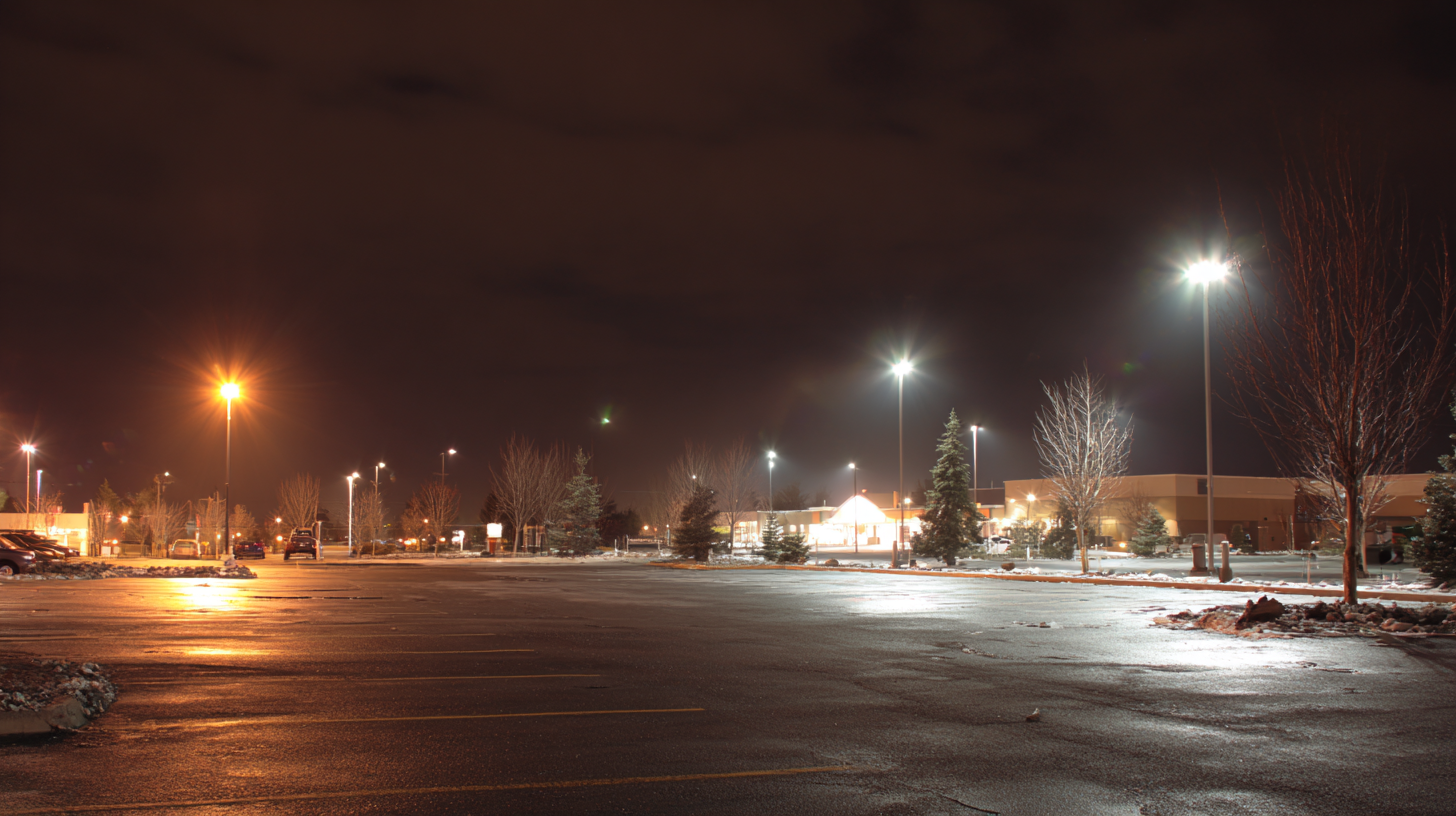Top Strategies for Choosing the Best Led Parking Lot Lights for Your Business
As businesses continue to prioritize safety and sustainability, selecting the right LED parking lot lights has become paramount. Recent industry reports indicate that proper outdoor lighting can reduce crime rates by up to 40% in commercial spaces, a crucial consideration for business owners looking to protect their investments and ensure customer safety. Moreover, the global LED lighting market is projected to reach $105.54 billion by 2025, highlighting the growing dependence on energy-efficient solutions like LED parking lot lights.
These lights not only provide enhanced visibility and security but also significantly lower energy costs through their long lifespan and reduced maintenance needs. As we delve into the top strategies for choosing the best LED parking lot lights for your business, understanding the critical aspects of efficiency, illumination, and design will empower you to make informed decisions that align with both your operational needs and environmental goals.

Top Considerations for Energy Efficiency in LED Parking Lot Lighting Solutions
When selecting LED parking lot lights, energy efficiency is a paramount consideration that can significantly impact both operational costs and environmental sustainability. According to the U.S. Department of Energy, LED lights use at least 75% less energy and last 25 times longer than incandescent lighting. This can lead to substantial savings on energy bills, critical for businesses aiming to optimize their overhead costs. By switching to LED lighting, companies can reduce their electricity consumption, which not only benefits their bottom line but also contributes to a lower carbon footprint.
Moreover, the lighting design plays a crucial role in maximizing energy efficiency. High-quality LED fixtures often come with advanced features, such as motion sensors and smart controls, which adjust the lighting levels based on actual use. A report by the International Energy Agency indicates that incorporating such technologies can decrease energy usage for outdoor lighting by up to 30%. Therefore, businesses should prioritize LED parking lot lighting solutions that integrate these innovations, ensuring that they are not only illuminating their surroundings but also doing so in the most efficient manner possible.

Key Features that Enhance Safety and Visibility in Commercial Parking Areas
When selecting LED parking lot lights for commercial areas, safety and visibility are paramount considerations. One of the key features to look for is brightness. High-lumen output ensures that parking areas are well-lit, reducing shadows and enhancing visibility for both pedestrians and vehicles. Additionally, lights with adjustable intensity settings can help adapt to different times of day and weather conditions, optimizing energy efficiency while maintaining safety.
Another important aspect is the color temperature of the lighting. Choosing LED lights with a color temperature around 4000K-5000K can create a more natural and inviting environment, improving visibility and reducing eye strain for drivers. Furthermore, the inclusion of motion sensors can provide added security by illuminating areas only when movement is detected, thus conserving energy and extending the lifespan of the fixtures. Finally, durability and weather resistance in the construction of the lights ensure reliable performance in various conditions, which is essential for maintaining safety in outdoor parking areas year-round.
Top Strategies for Choosing the Best LED Parking Lot Lights
Comparative Analysis: Cost-Effectiveness of LED vs. Traditional Parking Lot Lights
When it comes to illuminating parking lots, businesses face the crucial decision between LED lights and traditional lighting options. A comparative analysis reveals that LED lights not only have a higher initial cost but also offer significant long-term savings. With their low energy consumption, LED systems can reduce electricity bills by up to 50% compared to conventional lighting methods. This efficiency translates into a quicker return on investment, making LEDs a financially savvy choice for businesses looking to minimize operational costs.
Beyond energy savings, LED lights boast a longer lifespan, typically lasting up to 25,000 hours or more. In contrast, traditional lights often require frequent replacements, contributing to higher maintenance costs and labor. This durability of LEDs ensures that businesses can allocate resources more effectively, focusing on operations rather than constant upkeep of lighting systems.
Furthermore, with advancements in LED technology, options are available that improve light quality while minimizing glare and enhancing security—a critical factor for any parking lot environment.
Understanding the Longevity and Maintenance Requirements of LED Lighting Systems
 When selecting LED parking lot lights for your business, understanding the longevity and maintenance requirements of these lighting systems is crucial. LED lights are renowned for their extended lifespan, often lasting up to 50,000 hours or more. This longevity not only reduces the frequency of replacements but also translates to significant cost savings in the long run. Additionally, the durability of LED fixtures means they are less susceptible to damage from environmental factors, making them an ideal choice for outdoor settings.
When selecting LED parking lot lights for your business, understanding the longevity and maintenance requirements of these lighting systems is crucial. LED lights are renowned for their extended lifespan, often lasting up to 50,000 hours or more. This longevity not only reduces the frequency of replacements but also translates to significant cost savings in the long run. Additionally, the durability of LED fixtures means they are less susceptible to damage from environmental factors, making them an ideal choice for outdoor settings.
However, while LEDs are low-maintenance compared to traditional lighting options, they still require periodic inspections and maintenance to ensure optimal performance. Regular cleaning of the fixtures can prevent dirt and debris from obstructing light output, maintaining optimal visibility in your parking lot. Furthermore, it's essential to monitor the performance of the lighting system and replace any failing components promptly. Investing in quality LED parking lot lights from reputable manufacturers often comes with warranties that cover defects and provide peace of mind regarding maintenance issues, ensuring your business space remains brightly lit and safe for customers.
Impact of Smart Technology Integration on LED Parking Lot Lighting Performance
The integration of smart technology in LED parking lot lighting is reshaping how businesses manage their outdoor lighting systems. With advancements such as motion sensors, adaptive brightness, and remote monitoring capabilities, smart LED lights offer not just illumination but also intelligent management solutions. This technology enhances energy efficiency by ensuring that lights are only used when necessary, significantly reducing electricity costs and extending the lifespan of the fixtures.
Moreover, smart lighting systems provide valuable data analytics that can inform business decisions. By tracking usage patterns and peak hours, businesses can optimize their lighting schedules and ensure safety without over-illumination. Additionally, features like automated alerts for maintenance and system malfunctions create a proactive approach to facility management. This integration leads to improved safety and security in parking lots, making them more inviting for customers and reducing liability for business owners. As such, investing in smart LED parking lot lighting is not just about modern aesthetics; it’s about enhancing operational efficiency and creating a better overall experience for both businesses and their clientele.
Top Strategies for Choosing the Best Led Parking Lot Lights for Your Business - Impact of Smart Technology Integration on LED Parking Lot Lighting Performance
| Strategy | Description | Smart Technology Impact | Energy Efficiency Improvement |
|---|---|---|---|
| Opt for Motion Sensing | Integrate motion sensors to reduce unnecessary lighting. | Enhances security and reduces energy consumption. | Up to 30% savings on energy bills. |
| Smart Remote Management | Use apps to control lighting based on real-time demand. | Allows for better control and scheduling of lighting. | Potential for 40% energy reduction. |
| LED Light Quality | Choose high-quality LEDs for brighter, longer-lasting lights. | Smart dimming can prolong LED lifespan. | Increases efficiency by up to 50%. |
| Data Integration | Collect data on lighting usage and optimize accordingly. | Data-driven adjustments enhance performance. | Can cut energy waste by 25%. |
| Weather Adaptation | Use lights that adapt to weather conditions for better visibility. | Improves safety in all weather conditions. | Maintains efficient energy use regardless of conditions. |
